The Influence of the Functional Group on the Physicochemical and Biological Properties of New Phenanthro[9,10-d]-Imidazole Derivatives
Abstract
1. Introduction
2. Results and Discussion
2.1. Synthesis
2.2. Thermal Characteristics
2.3. Optical Properties
2.4. DFT Calculations
2.4.1. Chemical-Optical Properties
2.4.2. Biological Characteristics
2.5. Biological Properties
2.5.1. Cytotoxicity
2.5.2. Imaging of Fixed Stained Cells
2.5.3. Cell Imaging after Long-Term Exposition
2.5.4. Antimicrobial Activity
3. Materials and Methods
4. Conclusions
Supplementary Materials
Author Contributions
Funding
Institutional Review Board Statement
Informed Consent Statement
Data Availability Statement
Acknowledgments
Conflicts of Interest
References
- Kim, J.-H.; Park, K.; Nam, H.Y.; Lee, S.; Kim, K.; Kwon, I.C. Polymers for Bioimaging. Prog. Polym. Sci. 2007, 32, 1031–1053. [Google Scholar] [CrossRef]
- Yao, J.; Yang, M.; Duan, Y. Chemistry, Biology, and Medicine of Fluorescent Nanomaterials and Related Systems: New Insights into Biosensing, Bioimaging, Genomics, Diagnostics, and Therapy. Chem. Rev. 2014, 114, 6130–6178. [Google Scholar] [CrossRef]
- Wolfbeis, O.S. An Overview of Nanoparticles Commonly Used in Fluorescent Bioimaging. Chem. Soc. Rev. 2015, 44, 4743–4768. [Google Scholar] [CrossRef] [PubMed]
- Su, Y.; Yu, B.; Wang, S.; Cong, H.; Shen, Y. NIR-II Bioimaging of Small Organic Molecule. Biomaterials 2021, 271, 120717. [Google Scholar] [CrossRef] [PubMed]
- Kula, S.; Kaźmierski, Ł.; Filapek, M.; Krawczyk, P. Influence of a Bithiophene Substituent on the Properties of a New Fluorescent Probe-Theoretical and Experimental Study. J. Mol. Struct. 2023, 1281, 135151. [Google Scholar] [CrossRef]
- Jennings, L.E.; Long, N.J. ‘Two Is Better than One’—Probes for Dual-Modality Molecular Imaging. Chem. Commun. 2009, 24, 3511–3524. [Google Scholar] [CrossRef] [PubMed]
- Singh, N.; Sharma, U.C.; Sachan, S.; Sinha, S. Fundamentals of Bio-Nano Imaging; Sinha, S., Navani, N.K., Eds.; Studium Press LLC: Houston, TX, USA, 2014; Volume 12, pp. 1–25. [Google Scholar]
- Blum, A.G.; Gillet, R.; Athlani, L.; Prestat, A.; Zuily, S.; Wahl, D.; Dautel, G.; Gondim Teixeira, P. CT Angiography and MRI of Hand Vascular Lesions: Technical Considerations and Spectrum of Imaging Findings. Insights Into Imaging 2021, 12, 16. [Google Scholar] [CrossRef]
- Wei, L.; El Naqa, I. Artificial Intelligence for Response Evaluation With PET/CT. Semin. Nucl. Med. 2021, 51, 157–169. [Google Scholar] [CrossRef]
- Lassen, A.; Stokely, E.; Vorstrup, S.; Goldman, T.; Henriksen, J.H. Neuro-SPECT: On the Development and Function of Brain Emission Tomography in the Copenhagen Area. Clin. Physiol. Funct. Imaging 2021, 41, 10–24. [Google Scholar] [CrossRef]
- Kader, A.; Brangsch, J.; Kaufmann, J.O.; Zhao, J.; Mangarova, D.B.; Moeckel, J.; Adams, L.C.; Sack, I.; Taupitz, M.; Hamm, B.; et al. Molecular MR Imaging of Prostate Cancer. Biomedicines 2021, 9, 1. [Google Scholar] [CrossRef]
- Krawczyk, P.; Wybranowski, T.; Kaźmierski, Ł.; Hołyńska-Iwan, I.; Bratkowska, M.; Cysewski, P.; Jędrzejewska, B. 2′-(1H-Phenanthro[9,10-d]Imidazol-2-Yl)-Phenyl-4-Carboxylic Acid N-Hydroxysuccinimide Ester: A New Phenanthroimidazole Derivative as a Fluorescent Probe for Medical Imaging Applications. Spectrochim. Acta Part A 2020, 228, 117757. [Google Scholar] [CrossRef] [PubMed]
- Zhou, Y.; Wang, X.; Zhang, W.; Tang, B.; Li, P. Recent Advances in Small Molecule Fluorescent Probes for Simultaneous Imaging of Two Bioactive Molecules in Live Cells and in Vivo. Front. Chem. Sci. Eng. 2022, 16, 4–33. [Google Scholar] [CrossRef]
- Kula, S.; Krawczyk, P.; Kaźmierski, Ł.; Filapek, M. Synthesis, Physicochemical Characterization and Biological Properties of New 5-(1H-Phenanthro[9,10-d]Imidazol-2-Yl)-Thiophene-2-Carbaldehyde. J. Mol. Struct. 2022, 1252, 132122. [Google Scholar] [CrossRef]
- Owens, E.A.; Henary, M.; El Fakhri, G.; Choi, H.S. Tissue-Specific Near-Infrared Fluorescence Imaging. Acc. Chem. Res. 2016, 49, 1731–1740. [Google Scholar] [CrossRef]
- Kobayashi, H.; Ogawa, M.; Alford, R.; Choyke, P.L.; Urano, Y. New Strategies for Fluorescent Probe Design in Medical Diagnostic Imaging. Chem. Rev. 2010, 110, 2620–2640. [Google Scholar] [CrossRef]
- Krawczyk, P.; Jędrzejewska, B.; Pietrzak, M.; Janek, T. Synthesis, Spectroscopic, Physicochemical Properties and Binding Site Analysis of 4-(1H-Phenanthro[9,10-d]-Imidazol-2-Yl)-Benzaldehyde Fluorescent Probe for Imaging in Cell Biology: Experimental and Theoretical Study. J. Photochem. Photobiol. B 2016, 164, 112–122. [Google Scholar] [CrossRef]
- Tian, M.; Ma, Y.; Lin, W. Fluorescent Probes for the Visualization of Cell Viability. Acc. Chem. Res. 2019, 52, 2147–2157. [Google Scholar] [CrossRef]
- Luo, S.; Zhang, E.; Su, Y.; Cheng, T.; Shi, C. A Review of NIR Dyes in Cancer Targeting and Imaging. Biomaterials 2011, 32, 7127–7138. [Google Scholar] [CrossRef]
- Vahrmeijer, A.L.; Hutteman, M.; van der Vorst, J.R.; van de Velde, C.J.H.; Frangioni, J.V. Image-Guided Cancer Surgery Using near-Infrared Fluorescence. Nat. Rev. Clin. Oncol. 2013, 10, 507–518. [Google Scholar] [CrossRef]
- Shen, Q.; Wang, S.; Yang, N.-D.; Zhang, C.; Wu, Q.; Yu, C. Recent Development of Small-Molecule Organic Fluorophores for Multifunctional Bioimaging in the Second near-Infrared Window. J. Lumin. 2020, 225, 117338. [Google Scholar] [CrossRef]
- Zhu, H.; Fan, J.; Du, J.; Peng, X. Fluorescent Probes for Sensing and Imaging within Specific Cellular Organelles. Acc. Chem. Res. 2016, 49, 2115–2126. [Google Scholar] [CrossRef] [PubMed]
- Jiang, X.; Yang, R.; Lei, X.; Xue, S.; Wang, Z.; Zhang, J.; Yan, L.; Xu, Z.; Chen, Z.; Zou, P.; et al. Design, Synthesis, Application and Research Progress of Fluorescent Probes. J. Fluoresc. 2024, 34, 965–975. [Google Scholar] [CrossRef] [PubMed]
- Wawrzinek, R.; Ziomkowska, J.; Heuveling, J.; Mertens, M.; Herrmann, A.; Schneider, E.; Wessig, P. DBD Dyes as Fluorescence Lifetime Probes to Study Conformational Changes in Proteins. Chem.–Eur. J. 2013, 19, 17349–17357. [Google Scholar] [CrossRef]
- Krawczyk, P.; Jędrzejewska, B.; Pietrzak, M.; Janek, T. Synthesis, Photophysical Properties and Systematic Evaluations of New Phenanthroimidazole Fluorescent Probe for Bioimaging: Experimental and Theoretical Study. J. Photochem. Photobiol. B 2017, 166, 74–85. [Google Scholar] [CrossRef] [PubMed]
- Krawczyk, P.; Czeleń, P.; Cysewski, P. Reactive Group Effects on the Photophysical and Biological Properties of 2-Phenyl-1H-Phenanthro[9,10-d]Imidazole Derivatives as Fluorescent Markers. Org. Biomol. Chem. 2018, 16, 3788–3800. [Google Scholar] [CrossRef] [PubMed]
- Kula, S.; Krawczyk, P.; Filapek, M.; Maroń, A.M. Influence of N-Donor Substituents on Physicochemical Properties of Phenanthro[9,10-d]Imidazole Derivatives. J. Lumin. 2021, 233, 117910. [Google Scholar] [CrossRef]
- Kula, S.; Szlapa-Kula, A.; Kotowicz, S.; Filapek, M.; Bujak, K.; Siwy, M.; Janeczek, H.; Maćkowski, S.; Schab-Balcerzak, E. Phenanthro[9,10-d]Imidazole with Thiophene Rings toward OLEDs Application. Dye. Pigment. 2018, 159, 646–654. [Google Scholar] [CrossRef]
- Lee, W.; Yang, Y.; Cho, N.; Ko, J.; Hong, J.-I. Functionalized Organic Dyes Containing a Phenanthroimidazole Donor for Dye-Sensitized Solar Cell Applications. Tetrahedron 2012, 68, 5590–5598. [Google Scholar] [CrossRef]
- Kula, S.; Szlapa-Kula, A.; Filapek, M.; Bujak, K.; Kotowicz, S.; Siwy, M.; Grzelak, J.; Szalkowski, M.; Maćkowski, S.; Schab-Balcerzak, E. Novel Phenanthro[9,10-d]Imidazole Derivatives-Effect of Thienyl and 3,4-(Ethylenedioxy)Thienyl Substituents. Synth. Met. 2019, 251, 40–48. [Google Scholar] [CrossRef]
- Krebs, F.C.; Spanggaard, H. An Exceptional Red Shift of Emission Maxima upon Fluorine Substitution. J. Org. Chem. 2002, 67, 7185–7192. [Google Scholar] [CrossRef]
- Zhang, X.; Li, S.; He, Y.-J.; Han, T.; Wang, X.-L.; Chen, B.; Zou, K.-Y.; Li, Z.-X. Four Metal Complexes Based on Bulky Imidazole Ligands: Solvothermal Syntheses, Crystal Structures, and Fluorescence Properties. Z. Anorg. Allg. Chem. 2015, 641, 1874–1880. [Google Scholar] [CrossRef]
- Tan, Y.; Zhao, Z.; Shang, L.; Liu, Y.; Wei, C.; Li, J.; Wei, H.; Liu, Z.; Bian, Z.; Huang, C. A Novel Bipolar D–π–A Type Phenanthroimidazole/Carbazole Hybrid Material for High Efficiency Nondoped Deep-Blue Organic Light-Emitting Diodes with NTSC CIEy and Low Efficiency Roll-Off. J. Mater. Chem. C 2017, 5, 11901–11909. [Google Scholar] [CrossRef]
- Wang, Z.-Y.; Liu, B.; Zhao, J.-W.; Ruan, G.-L.; Tao, S.-L.; Tong, Q.-X. Bipolar Deep-Blue Phenanthroimidazole Derivatives: Structure, Photophysical and Electroluminescent Properties. Org. Electron. 2018, 52, 89–97. [Google Scholar] [CrossRef]
- Dixit, S.J.N.; Gupta, C.; Tadavi, T.H.; Chandrakumar, K.R.S.; Bose, S.; Agarwal, N. Phenanthroimidazole Derivatives Showing Mild Intramolecular Charge Transfer and High Quantum Yields and Their Applications in OLEDs. New J. Chem. 2021, 45, 16238–16247. [Google Scholar] [CrossRef]
- Nagarajan, N.; Velmurugan, G.; Venuvanalingam, P.; Renganathan, R. Tunable Single and Dual Emission Behavior of Imidazole Fluorophores Based on D-π-A Architecture. J. Photochem. Photobiol. A 2014, 284, 36–48. [Google Scholar] [CrossRef]
- Srinivasan, V.; Panneer, M.; Jaccob, M.; Pavithra, N.; Anandan, S.; Kathiravan, A. A Diminutive Modification in Arylamine Electron Donors: Synthesis, Photophysics and Solvatochromic Analysis-towards the Understanding of Dye Sensitized Solar Cell Performances. Phys. Chem. Chem. Phys. 2015, 17, 28647–28657. [Google Scholar] [CrossRef] [PubMed]
- Szlapa-Kula, A.; Kula, S.; Kaźmierski, Ł.; Biernasiuk, A.; Krawczyk, P. Can a Small Change in the Heterocyclic Substituent Significantly Impact the Physicochemical and Biological Properties of (Z)-2-(5-Benzylidene-4-Oxo-2-Thioxothiazolidin-3-Yl)Acetic Acid Derivatives? Sensors 2024, 24, 1524. [Google Scholar] [CrossRef]
- Kumar, D.; Thomas, K.R.J.; Lin, C.-C.; Jou, J.-H. Pyrenoimidazole-Based Deep-Blue-Emitting Materials: Optical, Electrochemical, and Electroluminescent Characteristics. Chem.-Asian J. 2013, 8, 2111–2124. [Google Scholar] [CrossRef]
- Kumar, D.; Thomas, K.R.J. Optical Properties of Pyrene and Anthracene Containing Imidazoles: Experimental and Theoretical Investigations. J. Photochem. Photobiol. A 2011, 218, 162–173. [Google Scholar] [CrossRef]
- Lipinski, C.A.; Lombardo, F.; Dominy, B.W.; Feeney, P.J. Experimental and Computational Approaches to Estimate Solubility and Permeability in Drug Discovery and Development Settings. Adv. Drug Deliv. Rev. 1997, 23, 3–25. [Google Scholar] [CrossRef]
- Lipinski, C.A. Drug-like Properties and the Causes of Poor Solubility and Poor Permeability. J. Pharmacol. Tox. Met. 2000, 44, 235–249. [Google Scholar] [CrossRef]
- Brinkley, M. A Brief Survey of Methods for Preparing Protein Conjugates with Dyes, Haptens and Crosslinking Reagents. Bioconj. Chem. 1992, 3, 2–13. [Google Scholar] [CrossRef] [PubMed]
- European Committee for Antimicrobial Susceptibility Testing (EUCAST) of the European Society of Clinical Microbiology and Infectious Diseases (ESCMID). Determination of Minimum Inhibitory Concentrations (MICs) of Antibacterial Agents by Broth Dilution. Clin. Microbiol. Infect. 2003, 9, ix–xv. [Google Scholar] [CrossRef]
- Clinical and Laboratory Standards Institute. Reference Method for Broth Dilution Antifungal Susceptibility Testing of Yeasts; Clinical and Laboratory Standards Institute: Wayne, PA, USA, 2012; M27-S4. [Google Scholar]
- Biernasiuk, A.; Kawczyńska, M.; Berecka-Rycerz, A.; Rosada, B.; Gumieniczek, A.; Malm, A.; Dzitko, K.; Łączkowski, K.Z. Synthesis, Antimicrobial Activity, and Determination of the Lipophilicity of ((Cyclohex-3-Enylmethylene)Hydrazinyl)Thiazole Derivatives. Med. Chem. Res. 2019, 28, 2023–2036. [Google Scholar] [CrossRef]
- Wiegand, I.; Hilpert, K.; Hancock, R.E.W. Agar and Broth Dilution Methods to Determine the Minimal Inhibitory Concentration (MIC) of Antimicrobial Substances. Nat. Protoc. 2008, 3, 163–175. [Google Scholar] [CrossRef]
- O’Donnell, F.; Smyth, T.J.P.; Ramachandran, V.N.; Smyth, W.F. A Study of the Antimicrobial Activity of Selected Synthetic and Naturally Occurring Quinolines. Int. J. Antimicrob. Agents 2010, 35, 30–38. [Google Scholar] [CrossRef]
- Frisch, M.J.; Trucks, G.W.; Schlegel, H.B.; Scuseria, G.E.; Robb, M.A.; Cheeseman, J.R.; Scalmani, G.; Barone, V.; Mennucci, B.; Petersson, G.A.; et al. Gaussian 09, Revision A.1; Gaussian, Inc.: Wallingford, CT, USA, 2009. [Google Scholar]
- Adamo, C.; Scuseria, G.E.; Barone, V. Accurate Excitation Energies from Time-Dependent Density Functional Theory: Assessing the PBE0 Model. J. Chem. Phys. 1999, 111, 2889–2899. [Google Scholar] [CrossRef]
- Guido, C.; Caprasecca, S. Corrected Linear Response, State-Specific Correction to Solvent Polarization Response. 2016. Available online: https://molecolab.dcci.unipi.it/images/tools_dwld/PisaLR.pdf (accessed on 12 June 2024). [CrossRef]
- Caricato, M. A Comparison between State-Specific and Linear-Response Formalisms for the Calculation of Vertical Electronic Transition Energy in Solution with the CCSD-PCM Method. J. Chem. Phys. 2013, 139, 044116. [Google Scholar] [CrossRef]
- Le Bahers, T.; Adamo, C.; Ciofini, I. A Qualitative Index of Spatial Extent in Charge-Transfer Excitations. J. Chem. Theory Comput. 2011, 7, 2498–2506. [Google Scholar] [CrossRef]
- Cancès, E.; Mennucci, B.; Tomasi, J. A New Integral Equation Formalism for the Polarizable Continuum Model: Theoretical Background and Applications to Isotropic and Anisotropic Dielectrics. J. Chem. Phys. 1997, 107, 3032–3041. [Google Scholar] [CrossRef]
- Morris, G.M.; Huey, R.; Lindstrom, W.; Sanner, M.F.; Belew, R.K.; Goodsell, D.S.; Olson, A.J. AutoDock4 and AutoDockTools4: Automated Docking with Selective Receptor Flexibility. J. Chem. Phys. 2009, 30, 2785–2791. [Google Scholar] [CrossRef] [PubMed]
- Cosconati, S.; Forli, S.; Perryman, A.L.; Harris, R.; Goodsell, D.S.; Olson, A.J. Virtual Screening with AutoDock: Theory and Practice. Expert Opin. Drug Discov. 2010, 5, 597–607. [Google Scholar] [CrossRef] [PubMed]
- Forli, S.; Olson, A.J. A Force Field with Discrete Displaceable Waters and Desolvation Entropy for Hydrated Ligand Docking. J. Med. Chem. 2012, 55, 623–638. [Google Scholar] [CrossRef] [PubMed]
- Sugio, S.; Kashima, A.; Mochizuki, S.; Noda, M.; Kobayashi, K. Crystal Structure of Human Serum Albumin at 2.5 Å Resolution. Protein Eng. Des. Sel. 1999, 12, 439–446. [Google Scholar] [CrossRef]
- Mueller-Dieckmann, C.; Panjikar, S.; Tucker, P.A.; Weiss, M.S. On the Routine Use of Soft X-Rays in Macromolecular Crystallography. Part III. The Optimal Data-Collection Wavelength. Acta Crystallogr. Sect. D 2005, 61, 1263–1272. [Google Scholar] [CrossRef]
- Trott, O.; Olson, A.J. AutoDock Vina: Improving the Speed and Accuracy of Docking with a New Scoring Function, Efficient Optimization, and Multithreading. J. Comput. Chem. 2010, 31, 455–461. [Google Scholar] [CrossRef]
- Potemkin, V.; Grishina, M. Principles for 3D/4D QSAR Classification of Drugs. Drug Discov. Today 2008, 13, 952–959. [Google Scholar] [CrossRef]
- Potemkin, V.A.; Grishina, M.A. A New Paradigm for Pattern Recognition of Drugs. J. Comput. Aided Mol. Des. 2008, 22, 489–505. [Google Scholar] [CrossRef]
- Potemkin, V.A.; Pogrebnoy, A.A.; Grishina, M.A. Technique for Energy Decomposition in the Study of “Receptor-Ligand” Complexes. J. Chem. Inf. Model. 2009, 49, 1389–1406. [Google Scholar] [CrossRef]
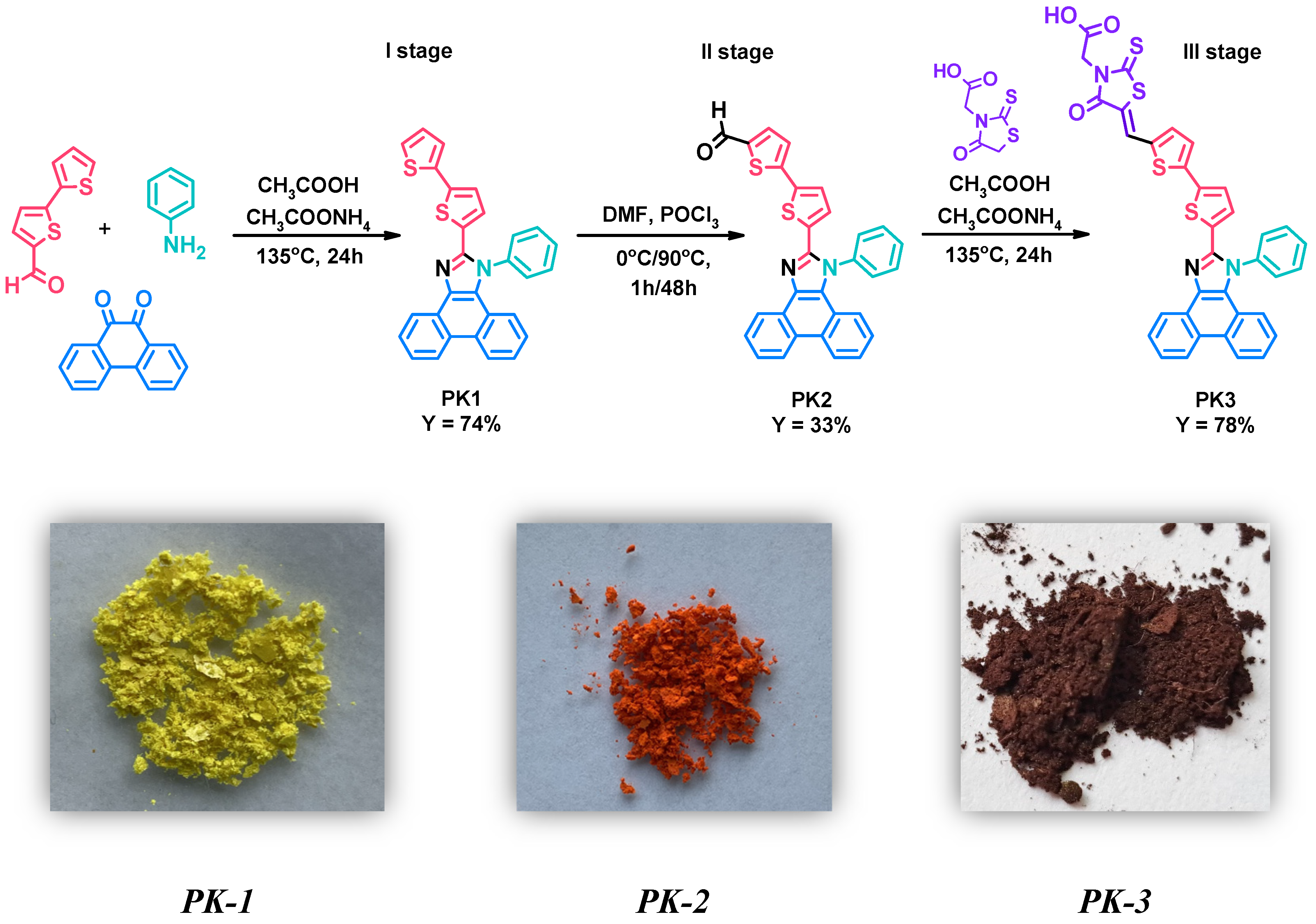
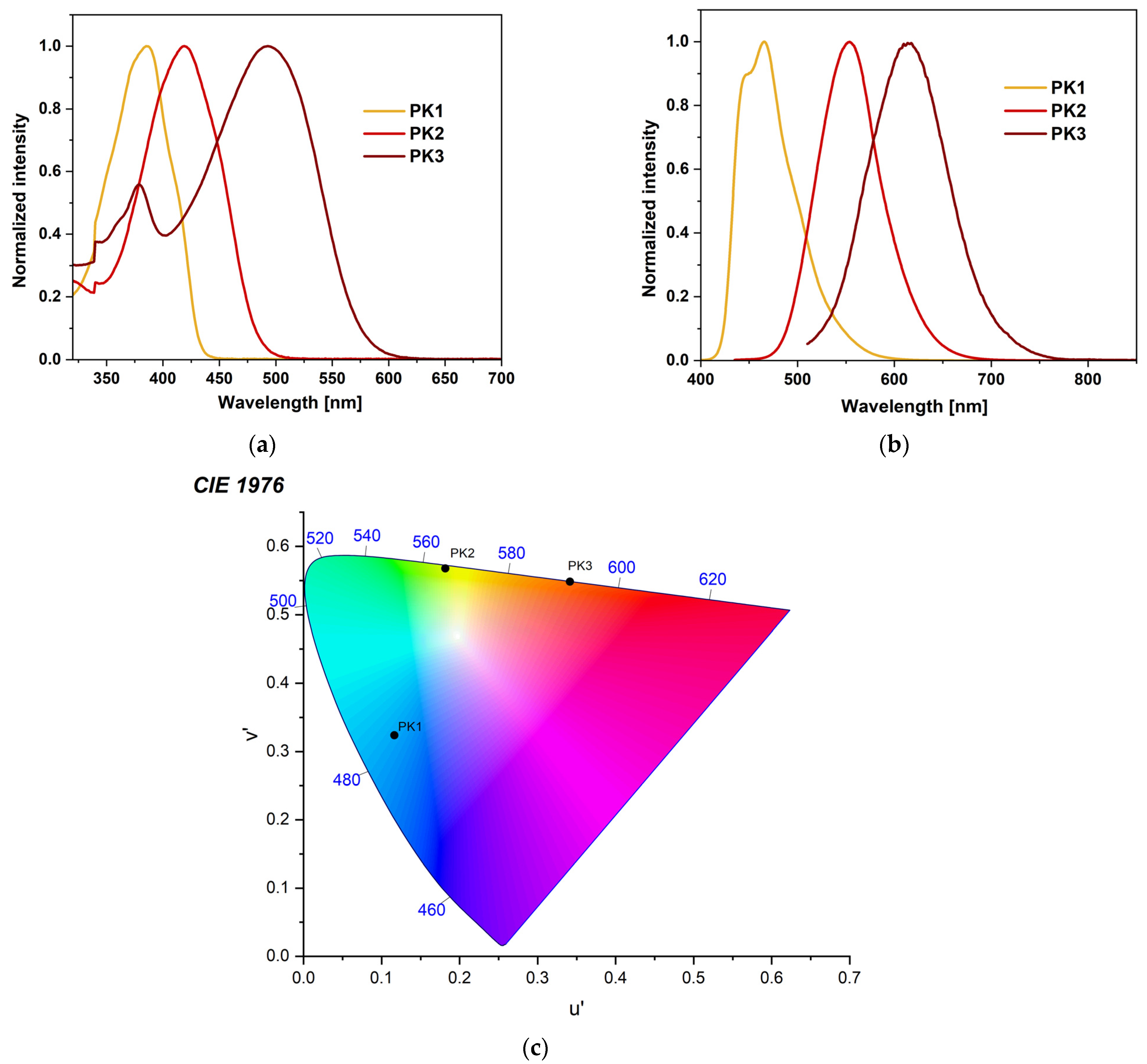
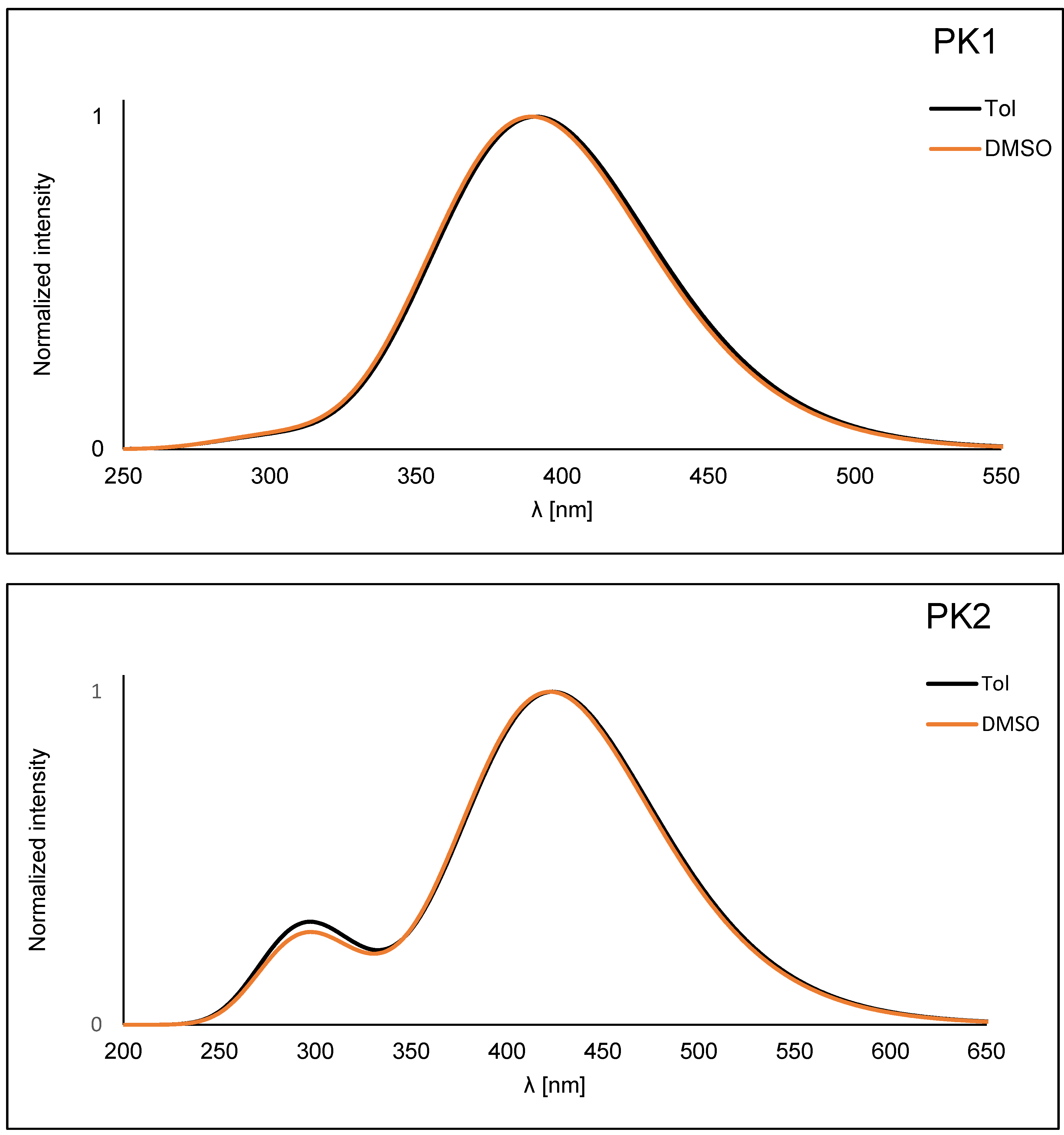
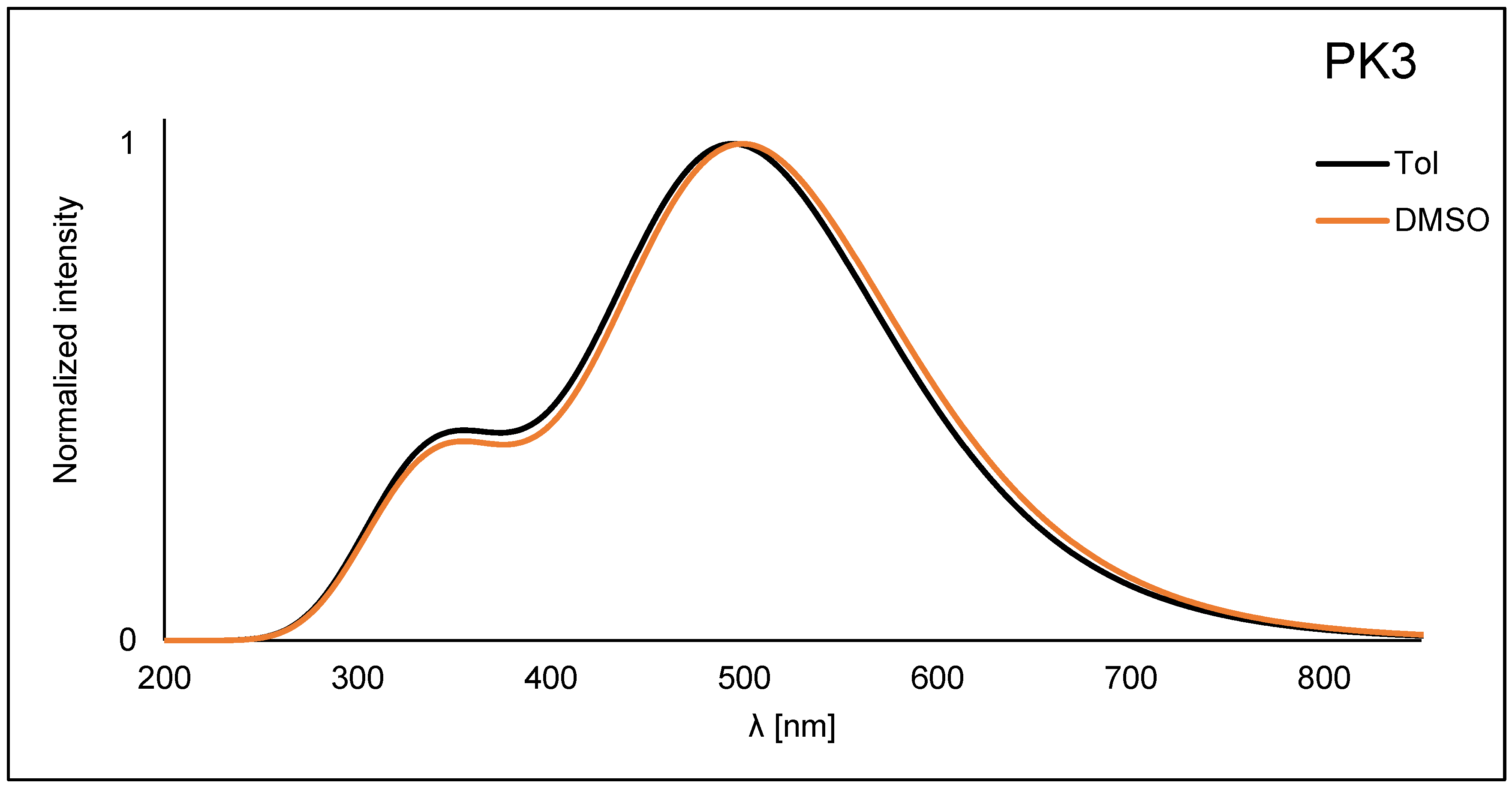
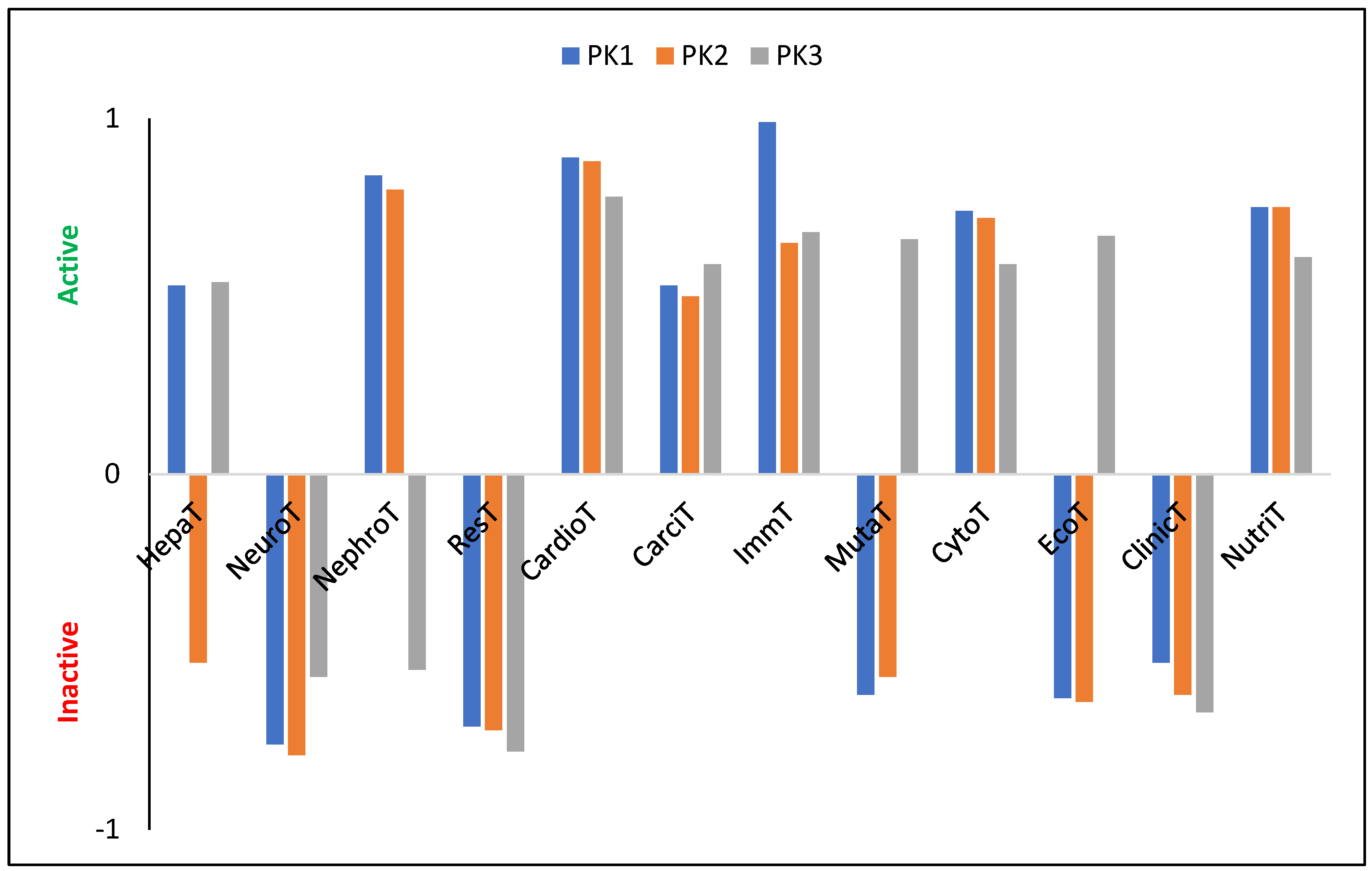
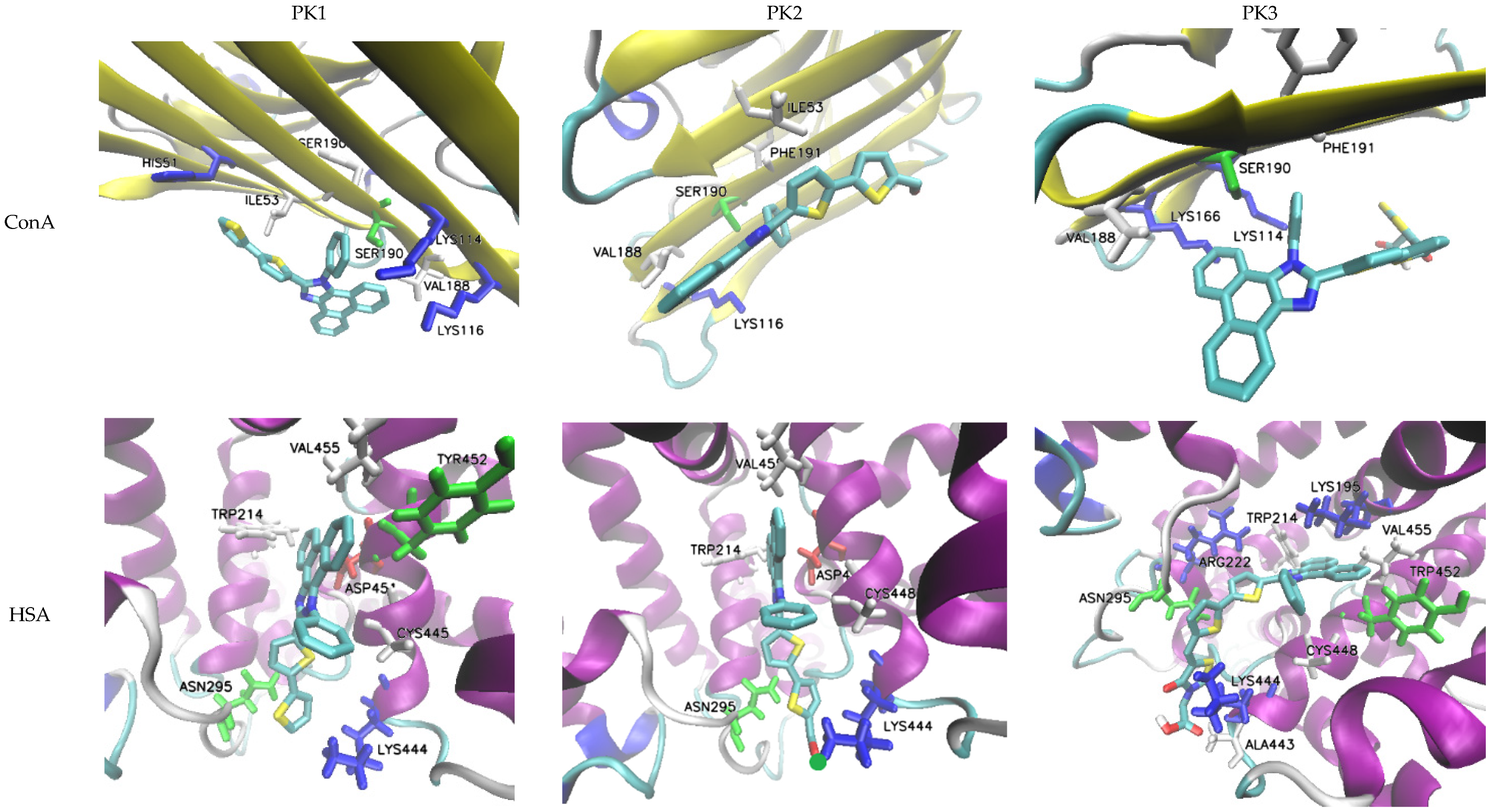
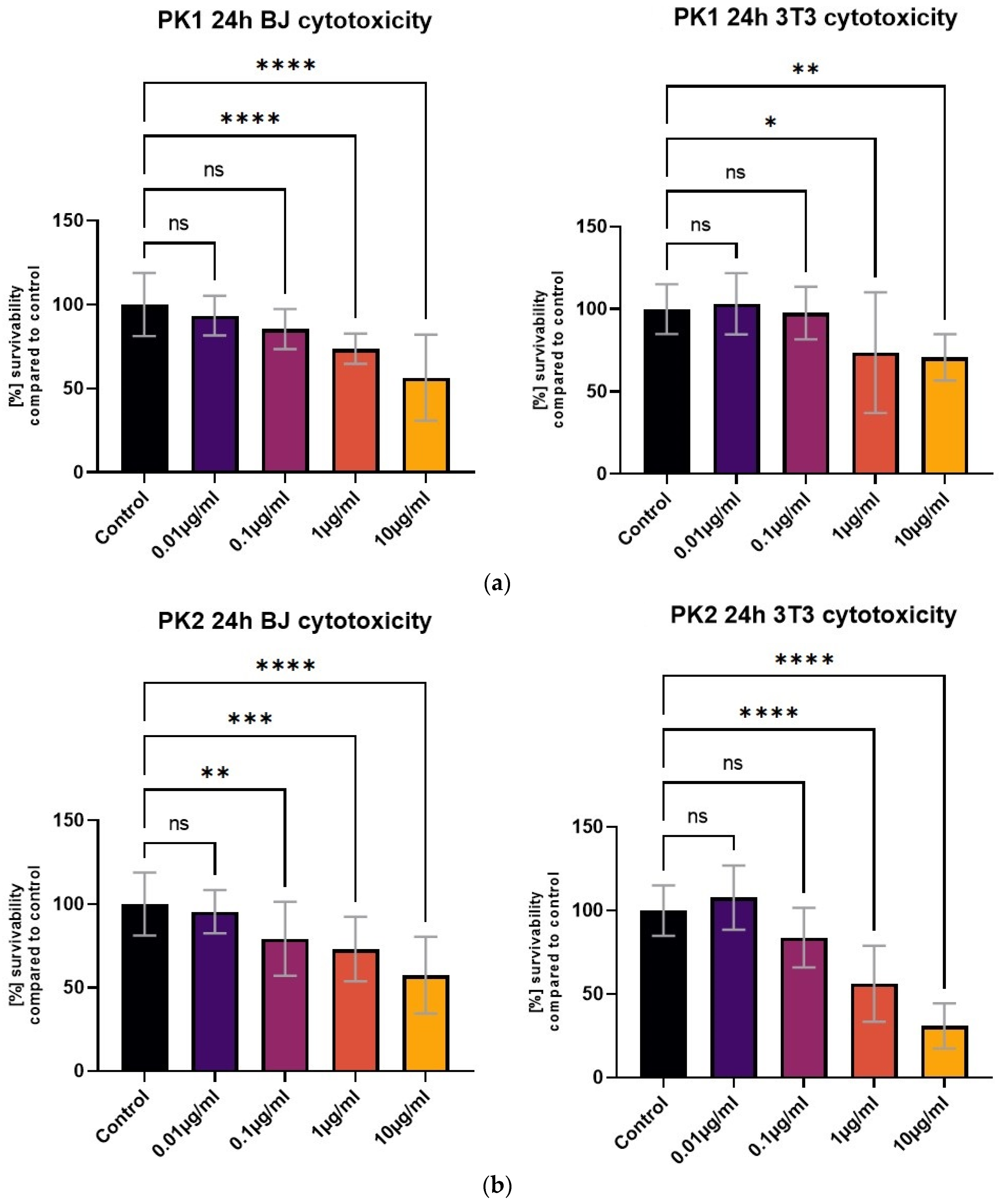


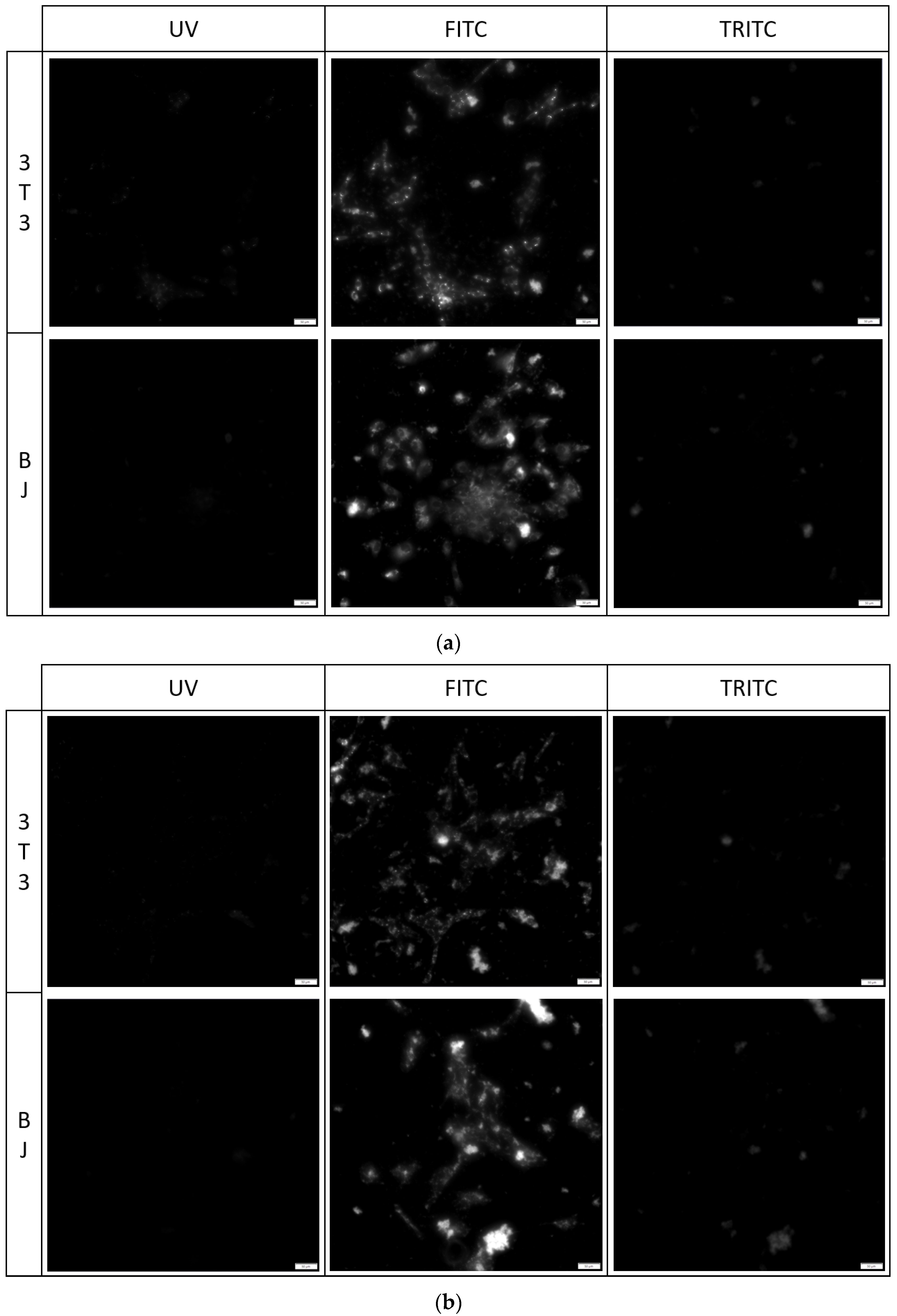
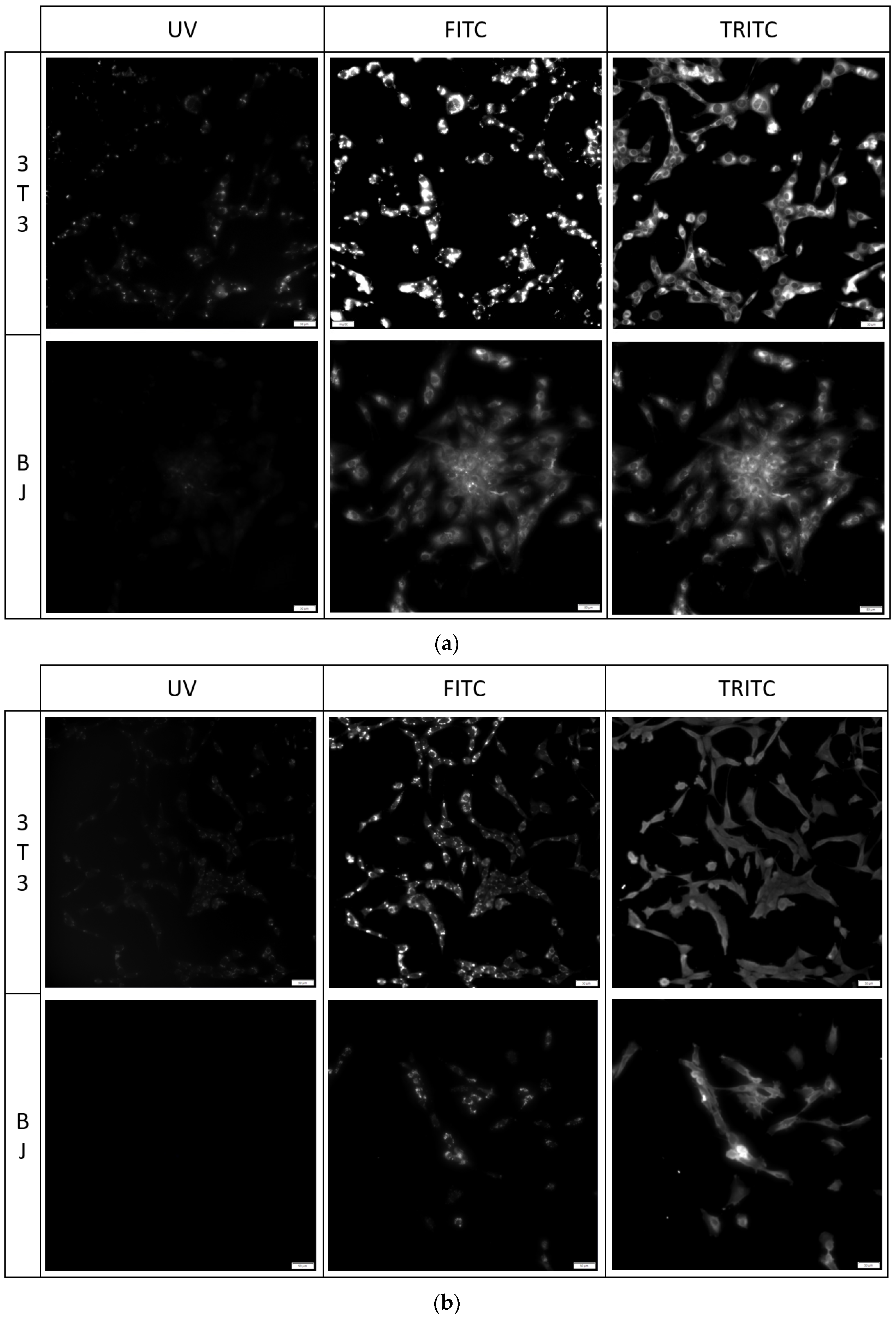
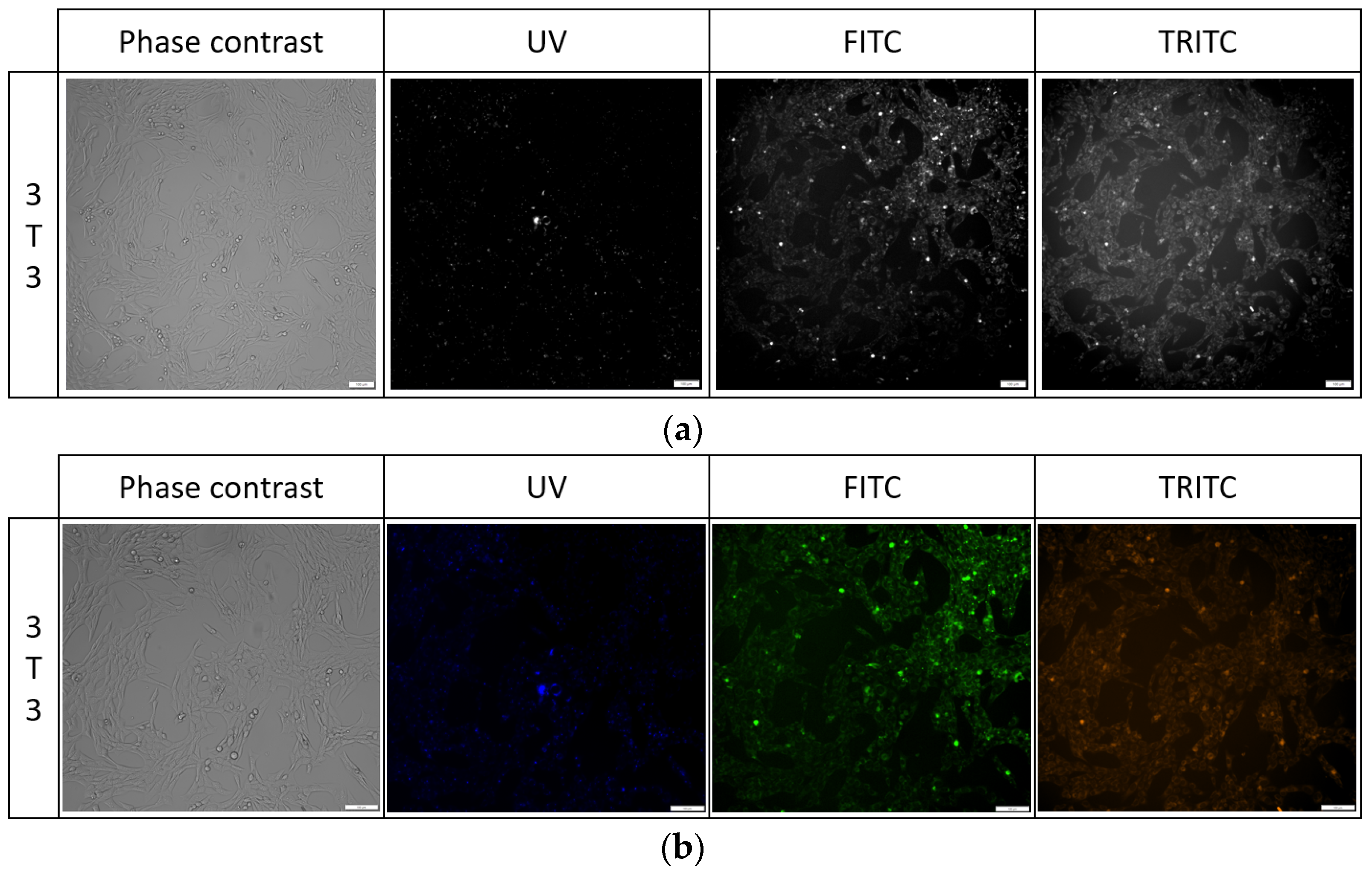
| Code | Tm a [°C] | T5 b [°C] | T10 b [°C] | Tmax c [°C] |
|---|---|---|---|---|
| PK1 | 265 | 313 | 341 | 393 |
| PK2 | 267 | 332 | 348 | 378 |
| PK3 | 355 | 331 | 347 | 362 |
| Compound | Solvent | λabs [nm] | λem [nm] | Stock Shift * [nm] | QY [%] | Chromaticity Coordinates u’, v’ |
|---|---|---|---|---|---|---|
| PK1 | Toluene | 384 | 437; 461 | 53 | - | 0.12; 0.29 |
| CHCl3 | 382 | 441; 464 | 59 | - | 0.12; 0.31 | |
| MeCN | 379 | 440sh; 458 | 61 | - | 0.12; 0.29 | |
| DMSO | 386 | 445; 465 | 59 | 26.8 | 0.11; 0.32 | |
| MeOH | 372 | 444; 465 | 72 | - | 0.13; 0.28 | |
| PK2 | Toluene | 421 | 495; 513sh | 74 | - | 0.08; 0.54 |
| CHCl3 | 420 | 531 | 111 | - | 0.13; 0.56 | |
| MeCN | 411 | 547 | 136 | - | 0.16; 0.56 | |
| DMSO | 418 | 553 | 135 | 14.5 | 0.18; 0.56 | |
| MeOH | 406 | 564 | 158 | - | 0.22; 0.56 | |
| PK3 | Toluene | 379; 492 | 581 | 89 | - | 0.30; 0.55 |
| CHCl3 | 380; 497 | 608 | 111 | - | 0.33; 0.54 | |
| MeCN | 374; 482 | 571sh; 607 | 125 | - | 0.29; 0.55 | |
| DMSO | 379; 493 | 614 | 121 | 0.6 | 0.34; 0.54 | |
| MeOH | 371; 471 | 585 | 114 | - | 0.29; 0.55 |
| PK1 | PK2 | PK3 | |
|---|---|---|---|
| 3T3 | 1 μg/mL UV | 0.1 μg/mL UV/FITC | 1 μg/mL UV/FITC/TRITC |
| BJ | 1 μg/mL UV | 0.1 μg/mL UV/FITC | 1 μg/mL UV/FITC/TRITC |
| Species | PK1 | PK2 | PK3 | CIP/VA * | |||||||||
|---|---|---|---|---|---|---|---|---|---|---|---|---|---|
| MIC | MBC | MBC/MIC | MIC | MBC | MBC/MIC | MIC | MBC | MBC/MIC | MIC | MBC | MBC/MIC | ||
| Gram-positive bacteria | Staphylococcus aureus MRSA ATCC 43300 | - | - | - | - | - | - | 1000 | >2000 | >2 | 0.24 | 0.24 | 1 |
| Staphylococcus aureus MSSA ATCC 25923 | - | - | - | - | - | - | 1000 | >2000 | >2 | 0.48 | 0.48 | 1 | |
| Staphylococcus aureus MSSA ATCC 6538 | 2000 | >2000 | >1 | 2000 | >2000 | >1 | 1000 | >2000 | >2 | 0.48 | 0.48 | 1 | |
| Staphylococcus aureus MSSA ATCC 29213 | - | - | - | - | - | - | 500 | >2000 | >4 | 0.48 | 0.48 | 1 | |
| Staphylococcus epidermidis ATCC 12228 | - | - | - | - | - | - | 1000 | >2000 | >2 | 0.12 | 0.12 | 1 | |
| Enterococcus faecalis ATCC 29212 | 2000 | >2000 | >1 | 2000 | >2000 | >1 | 1000 | >2000 | >2 | 0.98 * | 1.95 * | 2 * | |
| Micrococcus luteus ATCC 10240 | - | - | - | - | - | - | 1000 | >2000 | >2 | 0.98 | 1.98 | 2 | |
| Bacillus subtilis ATCC 6633 | 2000 | 2000 | 1 | 2000 | 2000 | 1 | 500 | >2000 | >4 | 0.03 | 0.03 | 1 | |
| Bacillus cereus ATCC 10876 | 2000 | >2000 | >1 | 1000 | >2000 | >2 | 500 | >2000 | >4 | 0.06 | 0.12 | 2 | |
| Gram-negative bacteria | Escherichia coli ATCC 25922 | - | - | - | - | - | - | 1000 | >2000 | >2 | 0.004 | 0.004 | 1 |
| Klebsiella pneumoniae ATCC 13883 | - | - | - | - | - | - | 1000 | >2000 | >2 | 0.12 | 0.12 | 1 | |
| Proteus mirabilis ATCC 12453 | - | - | - | - | - | - | 1000 | >2000 | >2 | 0.03 | 0.03 | 1 | |
| Salmonella Typhimurium ATCC 14028 | - | - | - | - | - | - | 1000 | >2000 | >2 | 0.06 | 0.06 | 1 | |
| Pseudomonas aeruginosa ATCC 27853 | - | - | - | - | - | - | 2000 | >2000 | >1 | 0.48 | 0.98 | 2 | |
| Species | PK1 | PK2 | PK3 | NY | |||||||||
|---|---|---|---|---|---|---|---|---|---|---|---|---|---|
| MIC | MFC | MFC/MIC | MIC | MFC | MFC/MIC | MIC | MFC | MFC/MIC | MIC | MFC | MFC/MIC | ||
| Fungi | Candida albicans ATCC 10231 | 2000 | 2000 | 1 | 2000 | 2000 | 1 | 2000 | 2000 | 1 | 0.48 | 0.48 | 1 |
| Candida albicans ATCC 2091 | 2000 | 2000 | 1 | 1000 | 2000 | 2 | 1000 | 2000 | 2 | 0.24 | 0.24 | 1 | |
| Candida parapsilosis ATCC 2201 | 1000 | 2000 | 2 | 500 | 2000 | 4 | 500 | 2000 | 4 | 0.24 | 0.48 | 2 | |
| Candida glabrata ATCC 90030 | 2000 | 2000 | 1 | 2000 | 2000 | 1 | 2000 | 2000 | 1 | 0.24 | 0.48 | 2 | |
| Candida krusei ATCC 14243 | 1000 | >2000 | >2 | 2000 | >2000 | >1 | 1000 | >2000 | >2 | 0.24 | 0.24 | 1 | |
| Candida auris CDC B11903 | 2000 | 2000 | 1 | 2000 | 2000 | 1 | 2000 | 2000 | 1 | 0.48 | 0.48 | 1 | |
Disclaimer/Publisher’s Note: The statements, opinions and data contained in all publications are solely those of the individual author(s) and contributor(s) and not of MDPI and/or the editor(s). MDPI and/or the editor(s) disclaim responsibility for any injury to people or property resulting from any ideas, methods, instructions or products referred to in the content. |
© 2024 by the authors. Licensee MDPI, Basel, Switzerland. This article is an open access article distributed under the terms and conditions of the Creative Commons Attribution (CC BY) license (https://creativecommons.org/licenses/by/4.0/).
Share and Cite
Kula, S.; Kalarus, P.; Kaźmierski, Ł.; Biernasiuk, A.; Krawczyk, P. The Influence of the Functional Group on the Physicochemical and Biological Properties of New Phenanthro[9,10-d]-Imidazole Derivatives. Molecules 2024, 29, 4703. https://doi.org/10.3390/molecules29194703
Kula S, Kalarus P, Kaźmierski Ł, Biernasiuk A, Krawczyk P. The Influence of the Functional Group on the Physicochemical and Biological Properties of New Phenanthro[9,10-d]-Imidazole Derivatives. Molecules. 2024; 29(19):4703. https://doi.org/10.3390/molecules29194703
Chicago/Turabian StyleKula, Slawomir, Paweł Kalarus, Łukasz Kaźmierski, Anna Biernasiuk, and Przemysław Krawczyk. 2024. "The Influence of the Functional Group on the Physicochemical and Biological Properties of New Phenanthro[9,10-d]-Imidazole Derivatives" Molecules 29, no. 19: 4703. https://doi.org/10.3390/molecules29194703
APA StyleKula, S., Kalarus, P., Kaźmierski, Ł., Biernasiuk, A., & Krawczyk, P. (2024). The Influence of the Functional Group on the Physicochemical and Biological Properties of New Phenanthro[9,10-d]-Imidazole Derivatives. Molecules, 29(19), 4703. https://doi.org/10.3390/molecules29194703






